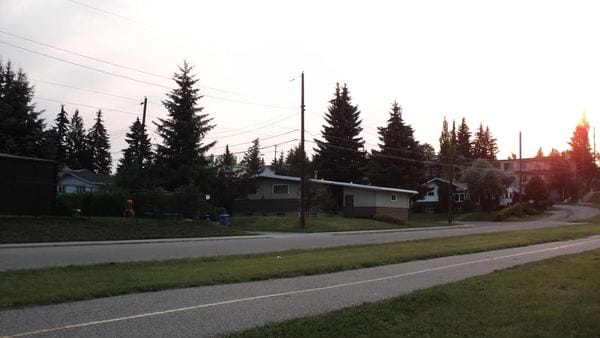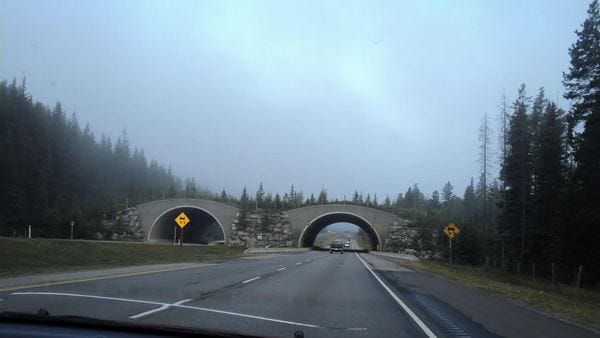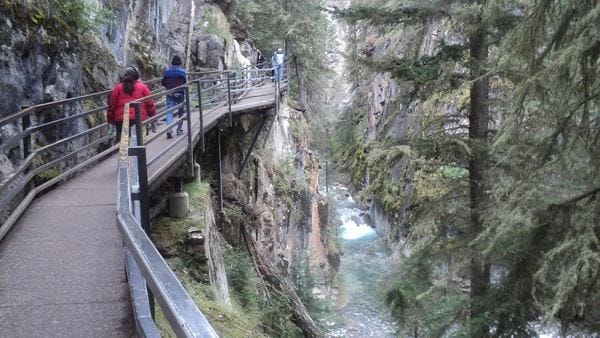Anything in plenty loses its value. Anything–even human life! That’s why when we read of treacherous genocide of thousands of innocent people somewhere away from our vicinity, the intensity of the sorrow that we feel is short-lived—we are able to carry on with our lives quite normally. We know, as individuals we can do jolly little to change anything on this planet.
Is that wholly true? I went to Calgary in Canada recently to spend time with my son and daughter-in-law. The wonderful roads, neat and even footpaths and walking trails and the marvelous traffic sense of the drivers of all kinds of vehicles struck me as I went out on my first walk there. Another striking aspect was the very low density of population.
Footpaths can be much more safer
I spent nearly three months there and drove to numerous places, but never did I find a single pothole on the roads, or protruding slabs on a footpath or open manholes. In case of any such rare occurrence, warning signals are displayed.
All the footpaths are wide enough for the few pedestrians, cyclists, board skaters and dog walkers to go around safely, away from the speeding vehicles. All the footpaths are just about four or five inches high and taper very smoothly at every junction. All buildings, public spaces and public transport vehicles are handicap-friendly. Buses lower a special ramp at bus stops for wheelchair users. Thus, I saw many physically challenged individuals going around independently in their motorised wheelchairs.

Neighbourhood roads in Calgary. Pic: Sudha Narasimhachar
There are stop signals at all by-lane junctions. Every vehicle invariably stops for a few seconds, whether there is anybody waiting to cross or not. If at all vehicles find a pedestrian near the junction, they wait for him or her to cross over. Pedestrians have the right to cross first and this rule is strictly followed.

Traffic signs on a highway. Pic: Sudha Narasimhachar
All traffic signs like speed limits, school zone, playground zone, parking, etc. are very clearly displayed all over the city, on all highways, in all interior residential areas, even in small villages, and inside parks and public spaces. Traffic violations are punished, hence nobody dares to break rules anywhere, even if there is only one vehicle and it is the middle of the night! Cameras are fixed in many places and there is patrolling. Most of the traffic signs and rules are universal, but how they are implemented is what makes all the difference in ensuring smooth traffic and avoiding accidents.
Not caring about maintaining parks
After seeing the parks in Calgary, I felt ashamed that we Bengalureans have to fight to save the little green patches like Cubbon Park or Lal Bagh! I mean ‘little’, because I realised how big a park could be only after seeing the parks there! A neighbourhood park in the locality where my son lives is vast, encompassing a golf course and many playgrounds, and is well maintained.
We fence our parks, guard them and lock up the gates, but parks in Calgary are never fenced and people walk in whenever they feel like. There are immaculate walking trails all over the park which run to miles, connecting many residential localities. The grass meadows and trees are all well kept. Even to fell a single sick or dead tree, the authorities notify the public, who are free to go and discuss the matter with them. Benches and picnic tables with dust bins are scattered throughout the parks. But there is no trash lying anywhere on the ground, even in crowded tourist spots.

A walking path to a canyon inside a forest. Pic: Sudha Narasimhachar
Once, we went to camp in a forest resort. I was wonderstruck to receive the key to our cabin at almost 11.30 pm in the night from the lone caretaker at the gate just by mentioning our booking details, hassle-free. There is no lighting outside the cabins or common bathrooms, and tourists are asked not to light campfires after ten in the night so as to not disturb the wildlife.
The lakes and rivers are also kept clean and pure with crystal clear water, although hundreds of tourists visit them regularly. I did not find anybody, not even a child, urinating or defecating in public, even in the forest areas. You can see at least temporary dry latrines dispersed along the highways and trekking ways, and they are stocked with toilet paper and hand sanitiser!
It’s all because they care about life
Why so many rules and instructions all over the country? It is because ‘life’ as such is respected. Every individual is important. Wild life, water bodies and forests are protected. The rights of physically challenged people are respected.
How many cases of road accidents do we come across in India in just one part of a city in a day? Pedestrians, especially senior citizens, lose their lives while crossing the roads or while walking on the roads because there are no footpaths. Don’t we have control over such things? If only we respect life, will we become responsible!
Taxes are collected, departments established and laws laid down. Yet, each of us faces so many hurdles in our daily lives, while carrying on with our routine affairs, let alone touring or enjoying holidays!

Bengaluru’s uneven and pothole-ridden footpaths make the walk an ordeal for senior citizens. They are sometimes forced to get on and off the footpaths and this can prove tiresome. Pic: Rahul Ravi
For instance, all the footpaths in Yelahanka Satellite Town were replaced with concrete slabs after removing the good stone slabs. Footpaths are nearly eight to ten inches higher than the road level with no slope at any junction. Senior citizens, the sick and handicapped people cannot climb these footpaths. The footpaths are so uneven and narrow in places where the trees intercept.
Let’s learn from others
Yes. We definitely need trees. Let not BBMP raze those trees! Just make footpaths more pedestrian-friendly. The concrete blocks wear away quickly because of the roots of the trees or other reasons. Thus, pedestrians have to be very watchful about slabs that jut out, open ditches, protruding iron frames and what not!
All our administrators and politicians travel around the world so often. Don’t they ever feel like aping the good from other countries? We can ape other cultures so easily, adopt food habits, lifestyles, fashion statements and so many other things, but we cannot copy things that might make the lives of the common man easier. We don’t care for the deaths of endangered species due to road accidents inside forest reserves, let alone taking care of those that stray into cities! Our only excuse is ‘uncontrollable growth of population’.
Where are the attempts from government towards achieving safe living environment? ‘Widen the roads, widen the roads’ is the only call that is answered. Nobody cares for the majority of the commoners, who too have rights to use the roads, the footpaths, the parks and every facility. For them, it is just sufficient if the car-owners can drive around without inconveniences which is also not happening because of bad traffic management. There are many lessons to be learnt in these aspects from other nations. Let us first learn them!
Related Articles
In pictures: Bangalore’s footpaths – An army grade obstacle course!
Speedbreakers have no art and no science in Bangalore’s roads!
Walls – life in India through a foreigner’s eyes
Hmm… All we need to do is find “undiscovered” land; kill all the “natives” and plunder the land and live happily ever after! [Mars, anyone?]
Great observations, except for the suggestion under “Let’s learn from others”
(Playing the devil’s advocate here)
Do people in Calgary have
1) vendors on footpaths?
2) Buildings/Homes/Businesses encroaching on footpaths with sloping drive ways / extended shops etc?
3) Did Calgary citizens cry hoarse when street vendors were evicted from footpaths? (let me guess, they never had street vendors on footpaths)
4) Do the footpaths have gigantic 50 or 100 yr old trees? If not, probably those were removed without people resorting to protests and chipkoo movements?
The point I’m trying to make, is that we love to blame the govt, whether they evict vendors, clear trees, to make way for footpaths, or if they choose the other option and let footpaths never exist.
Its time for Banglorean’s to own up to the lack of footpaths and have a strong heart, ask for trees and footpath vendors to be removed. Also, get rid of sloping ramps for vehicles / stairs for people that encroach on the foot path (this is rampant in Malleshwara, both in residential and commercial areas). The can be moved inside the land owner’s area.
Without fixing the problem with gigantic trees lining the roads, and vendors, shops/houses encroaching the footpaths, government cannot fix the pedestrian problem.
PS: I live in the US, and I have not come across a single road that is so heavily lined with huge, unmaintained old trees (not saying such roads do not exist). What seems to work here (especially in cities) is that a road with two lanes of traffic each way, will have one lane of parking each way, + 1.5 to 2 lanes of footpath on each side (building to building, there’s about 10 lanes of distance across the road).
Assuming the dense areas of bangalore can have only one lane of traffic each way, it still needs 6 lane width roads, just to accommodate footpaths without parking!
Not just Bangalore, but almost anyplace in India. Chandigarh is reasonably good (it is a planned city). Singapore is a beautiful example of how trees, vendors and footpaths coexist. Only one who walks in Blr will realise the value of the trees on the footpaths, not those in the cars.
I expected these comments! We always have excuses! As though we are protecting all the tribal population in our country! We have been driving eco-friendly tribes out of their native forests and destroying forests for commercial projects! My point was how we could be more pedestrian-friendly within the available system. As Arathi says, only the 90% commoners who wait in shelterless busstands or walk miles in the hot sun know the value of the trees! When you widen roads, you can plan for a proper footpath and a row of trees! It only needs a little more of concern for all categories of people. Yes. Footpath vendors and shops that extend to footpaths have to be dealt with. That is the challenge! Maybe you could enforce rules strictly against hotels and shops using footpaths freely and for street vendors provide a specific space. If there is a strong will, there is a way! Let alone Malleshwaram or Gandhi Bazaar! What about the other roads in residential localities? Why such unscientific method of laying footpaths? No senior citizen or disabled climb over the footpath! Chopping trees is not the only way of having good footpaths. The urban green cover is protected and supported in all major cities around the world to bring down pollution and dust. The ecologists and planners have to sit together and plan. Like on Nandidurg Road, you could have trees in the centre and have roads on either side. It is not an impossible situation. How many pedestrians had to lay down their lives near Esteem Mall for the authorities to plan a skywalk? But these skywalks without lifts are of no use to senior citizens and disabled. How will they climb such high skywalks? Of course urban planning is not easy. So many issues have to be considered. And with the density of population being so high, it is tougher. But should we not be more responsible? Why should we oppose an Act that could lay down stringent traffic rules? Wouldn’t that ensure safer traffic? I don’t think people will grumble to give away their lands or buildings for providing better civic facilities, if they are compensated well. Haven’t people done that for Namma Metro? But if such lands are given away for a song to private builders, who only illegally raise structures on footpaths, cause traffic jams and congestion, then of course we will raise our voice!
Problems:
1) BBMP/BDA has no concept of “planning”
2) Footpaths, even for the newest localities either do not exist, or are an after thought.
3) Street parking is almost always never planned.
4) Street Vendors exist by way of encroachments, not because BBMP/BDA allocates space on the road sides for vendors.
Many areas in older Bangalore (Malleshwaram/Jayanagar), in the market areas, footpaths are used completely by vendors. Bleeding hearts are the reason these vendors have to operate in such unplanned way. Go to the farthest new area that is being developed by BDA/BBMP or a private layout. You’ll see no solutions being implemented for the problems 1 to 4 I have listed.
When we (the govt and the people) don’t create new residential / commercial areas the right way, how can we expect anything else to improve in the existing areas of bangalore?
Solution: (commercial areas)
Demolish one row of commercial buildings on each side.
Keep the trees as they are
Create specific vendor area between the trees.
Clear, uniform width and leveled footpaths can be created in place of the demolished rows.
Wider footpaths will prevail.
Wider, uniform, clean and nice footpaths, will go to a great extent in easing vehicular traffic congestion too!
Similarly, create a multi level parking for every few blocks in commercial / residential areas. Homes / Commercial establishments with no off road parking spot, should be forced to pay a good amount of tax, which can enable them to park at these multi level parking spots for reduced price. Doing so, will help the encroachment of footpaths by cars in residential areas.